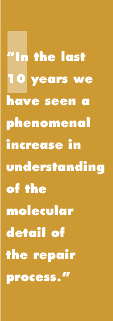 If scientists can disable cancer cells’ repair mechanisms, cancer will be easier to kill. As
you read this, DNA throughout your body is being damaged —
by the routine wear and tear of everyday cellular activity, by ordinary
glitches in cell division and by outside malefactors like ultraviolet
light and tobacco smoke. Fortunately, molecular maintenance teams
are also at work, constantly scanning your DNA for trouble. When
a problem is detected, they flag the area for repair, temporarily
halt cell operations and call in specialized crews that slice out
damaged stretches of DNA, manufacture and install replacement parts
and clean up debris. It’s a system of amazing power and efficiency,
comprising hundreds of specialized genes and proteins. Without it,
cells would break down, mutations would build up and cancer risk
would accelerate.
Home |
Table of Contents |
To our Readers |
Building on Basics UC Davis Health System | © 2000, 2001, 2002 UC Regents. All rights reserved. |
|


